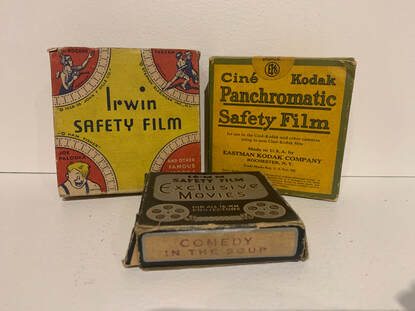|
Irwin Safety Film, c. 1930s
|
FILM
16mm was an inexpensive type of film often used by amateurs. The film itself was first sold by Eastman Kodak in the early 1920s and it earned the title of safety film due to its acetate composition, as opposed to the highly flammable nitrate based 35mm film. The popularity of 16mm film continued for several decades due to its economical accessibility, but later 8mm film, first released in 1932, and Super 8 film, first released in 1965, eclipsed the 16mm film for home use because they were less expensive. |
EARLY ANIMATION
The advent of animation in popular culture began in the nineteenth century, at first on simple flat discs that spin on a phenakistiscope, and then quickly progressed to sequential images on a cylindrical toy called a zoetrope. Other devices, such as the thaumotrope, trick the eye into seeing images on opposite sides of paper simultaneously. The animation relies on the speed at which the eye communicates visual information to the brain.
The advent of animation in popular culture began in the nineteenth century, at first on simple flat discs that spin on a phenakistiscope, and then quickly progressed to sequential images on a cylindrical toy called a zoetrope. Other devices, such as the thaumotrope, trick the eye into seeing images on opposite sides of paper simultaneously. The animation relies on the speed at which the eye communicates visual information to the brain.
STEREOSCOPE AND STEREOGRAM
Stereopsis happens when two images are slightly offset. Stereopsis is a perception of depth made by using both eyes in combination, which creates a 3d effect. The viewer, or stereoscope, holds the stereograms in place for easy viewing
Stereopsis happens when two images are slightly offset. Stereopsis is a perception of depth made by using both eyes in combination, which creates a 3d effect. The viewer, or stereoscope, holds the stereograms in place for easy viewing
ZOETROPE
Similar to the phenakistiscope and one of the earliest animation toys, zoetropes were named from the Greek zoe (life) and tropos (turning), or “wheel of life” by William E. Lincoln. A series of single images simulate movement by the spinning of the device and the viewer peeks through tiny slits in the side. Although the concept of the zoetrope was invented in the 1830s, similar devices existed thousands of years prior to this.
Similar to the phenakistiscope and one of the earliest animation toys, zoetropes were named from the Greek zoe (life) and tropos (turning), or “wheel of life” by William E. Lincoln. A series of single images simulate movement by the spinning of the device and the viewer peeks through tiny slits in the side. Although the concept of the zoetrope was invented in the 1830s, similar devices existed thousands of years prior to this.
PHENAKISTISCOPE
The phenakistiscope was the first popular animation toy, appearing in 1832, that used a series of sequential images on a disc to convey fluid movement
The phenakistiscope was the first popular animation toy, appearing in 1832, that used a series of sequential images on a disc to convey fluid movement
PRAXINISCOPE
A praxiniscope, invented in the 1870s, used sequential images to convey movement on the inside of a cylinder, similar to a zoetrope. Charles-Emile Reynaud, the inventor, improved upon the earlier animation devices by adding mirrors to the interior cylinder to view the sequential static images that appeared to move. Unlike the zoetrope, because of the placement of the mirrors viewers no longer had to view the animation through slits in the side.
A praxiniscope, invented in the 1870s, used sequential images to convey movement on the inside of a cylinder, similar to a zoetrope. Charles-Emile Reynaud, the inventor, improved upon the earlier animation devices by adding mirrors to the interior cylinder to view the sequential static images that appeared to move. Unlike the zoetrope, because of the placement of the mirrors viewers no longer had to view the animation through slits in the side.
THAUMOTROPE
From the Ancient Greek meaning “wonder turner,” thaumotropes were popular toys in the 19th century. William Henry Fitton and British physician John Ayrton Paris were both credited with the invention of the thaumotrope. As you spin the thaumotrope, the images on either side appear together due to the speed at which the retina of your eye sends information to your brain, and the delay in processing the visual information. The faster you spin the thaumotrope, the clearer the images on either side merge together because the brain processes the images almost simultaneously. WOW!
From the Ancient Greek meaning “wonder turner,” thaumotropes were popular toys in the 19th century. William Henry Fitton and British physician John Ayrton Paris were both credited with the invention of the thaumotrope. As you spin the thaumotrope, the images on either side appear together due to the speed at which the retina of your eye sends information to your brain, and the delay in processing the visual information. The faster you spin the thaumotrope, the clearer the images on either side merge together because the brain processes the images almost simultaneously. WOW!
MOTION PICTURE FILM FOR KINETOSCOPE
“Santa Clause and the Clubman"
Used with Edison Home Kinetoscope, c. 1892
Kinetoscopes predate the use of projectors to show movies, and instead, through a peephole, allowed one viewer at a time to watch a fast moving sequence of images on a film strip that simulated movement
“Santa Clause and the Clubman"
Used with Edison Home Kinetoscope, c. 1892
Kinetoscopes predate the use of projectors to show movies, and instead, through a peephole, allowed one viewer at a time to watch a fast moving sequence of images on a film strip that simulated movement
FILM PROJECTORS
Photographer Eadweard Muybridge (1830-1904) invented the earliest film projector in 1879, the zoopraxiscope, which projected images on rapidly rotating glass discs that gave the impression of movement. Inventors continued to improve upon the projector in the 19th century, and in 1888 Louis Le Prince (1841-1890) captured the first motion picture film. Less than a decade later, Auguste and Louis Lumiere (1862-1954 and 1864-1948, respectively) improved upon the “Cinematographe Leon Bouly” or cinematograph, a motion picture film camera and movie projector that allowed several people to view the same movie, unlike Thomas Edison’s Kinetoscope. The film projector reigned for over a century, but was replaced in movie theaters and elsewhere by digital projectors in the last couple of decades because of their superior image resolution.
Photographer Eadweard Muybridge (1830-1904) invented the earliest film projector in 1879, the zoopraxiscope, which projected images on rapidly rotating glass discs that gave the impression of movement. Inventors continued to improve upon the projector in the 19th century, and in 1888 Louis Le Prince (1841-1890) captured the first motion picture film. Less than a decade later, Auguste and Louis Lumiere (1862-1954 and 1864-1948, respectively) improved upon the “Cinematographe Leon Bouly” or cinematograph, a motion picture film camera and movie projector that allowed several people to view the same movie, unlike Thomas Edison’s Kinetoscope. The film projector reigned for over a century, but was replaced in movie theaters and elsewhere by digital projectors in the last couple of decades because of their superior image resolution.
MAGIC LANTERN
Lanterna magica, or magic lantern, projects images using a light source behind the image and lens. First developed in the 1600s, they were used for entertainment, and during its early history one could witness a magic lantern brought to town by a traveling entertainer. One very popular type of magic lantern during the nineteenth century, a Phantasmagoria, featured terrifying and grotesque images to shock the audience.
Lanterna magica, or magic lantern, projects images using a light source behind the image and lens. First developed in the 1600s, they were used for entertainment, and during its early history one could witness a magic lantern brought to town by a traveling entertainer. One very popular type of magic lantern during the nineteenth century, a Phantasmagoria, featured terrifying and grotesque images to shock the audience.
Iredell Museums received an NC CARES: Humanities Relief Grant from the North Carolina Humanities Council, www.nchumanities.org. Funding for NC CARES has been provided by the National Endowment for the Humanities (NEH) as part of the Coronavirus Aid, Relief and Economic Security (CARES) Act economic stabilization plan.


